Last updated: June 20, 2025
Article
Insights from an Outbreak: Research Opportunities came with the Spruce Beetle
By Mariana Perez, Scientist-in-Park Intern & Sarah Stehn, Fire Ecologist
Last update: April 2025
In the last few years, Denali National Park and Preserve has seen an increase in beetle related spruce mortality. With the moving front of spruce beetle infestation has come opportunity for research and monitoring.
Long-Term Monitoring Sets the Stage
In the 1990s, the National Park Service initiated a Long-Term Ecological Monitoring (LTEM) Program in Denali National Park and Preserve. The main goal of the LTEM program was to obtain and maintain an inventory of the type and condition of natural resources that park management would be responsible for. Denali was one of four parks chosen to chart the course for other parks. The LTEM program later expanded into the Inventory and Monitoring (I&M) Program, providing additional support for research and monitoring intended to aid park managers in their role of protecting park resources for future generations.
The long-term monitoring projects born from these programs established a baseline status of many of the Parks’ natural resources (i.e., birds, large mammals, forest health, etc.). From this baseline information, and other past research documented in parks, park managers and researchers can directly measure change, expected or unexpected, over time. Learn more about long-term monitoring in parks here: Taking the pulse of US national parks · Frontiers for Young Minds.
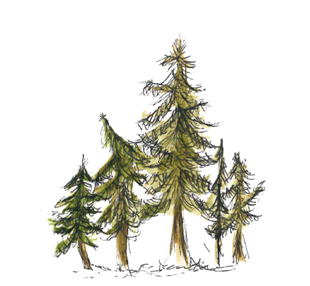
NPS Illustration / M. Perez
Vegetation as the Texture of the Landscape
As part of the LTEM program, Denali staff established study sites in Rock Creek watershed near park headquarters. With separate sites selected within areas of permafrost, forest, and alpine environments, the Rock Creek watershed would offer a glimpse at how change may occur in across these different ecosystems. Forest sites in the Rock Creek watershed have been heavily affected by spruce beetle and continued monitoring will capture response to that change.
This vegetation monitoring effort was continued and massively expanded through the Central Alaska Network (CAKN) Vegetation Monitoring program which now conduct periodic monitoring at nearly 1,000 sites in Denali National Park and Preserve, and hundreds more in other Alaskan parks.
Monitoring conducted by the Central Alaska Network and Denali National Park and Preserve Botany Teams

NPS Illustration / M. Perez
Large Mammals Follow the Food
Wildlife biologists at Denali National Park and Preserve have spent decades studying animals with large home ranges, such as wolves, caribou, moose and bear. With long-term monitoring, Denali researchers can document the effects of ecological and climatic processes on wildlife population and their habitats. Over the longer-term, potential shifts from a spruce-dominated forest to one with greater proportion of deciduous trees and shrubs may be beneficial to animals that browse those species. Long-term monitoring data will be critical in understanding possible changes in how animals utilize their changing habitats.
Monitoring conducted by the Denali National Park and Preserve Wildlife Biology Team
New Opportunities Came with the Beetle
Below are brief summaries of just some of the research that has arisen due to spruce beetle as a forest disturbance. Summaries are paraphrased from the researchers’ own words.
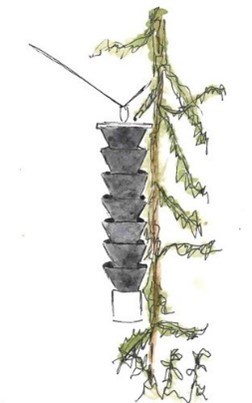
NPS Illustration / M. Perez
Monitoring Beetle Populations
The Alaska Division of Forestry & Fire Protection coordinates bark beetle monitoring efforts across numerous locations annually, from Southeast Alaska to the Interior. In coordination with Denali National Park and Preserve and other nearby affected landowners within the ongoing spruce beetle outbreak, they maintain a network of traps to monitor spruce beetle. The data collected help them assess relative spruce beetle population size and flight timing, both of which can influence management recommendations.
Research conducted by the Alaska Division of Forestry and Fire Protection
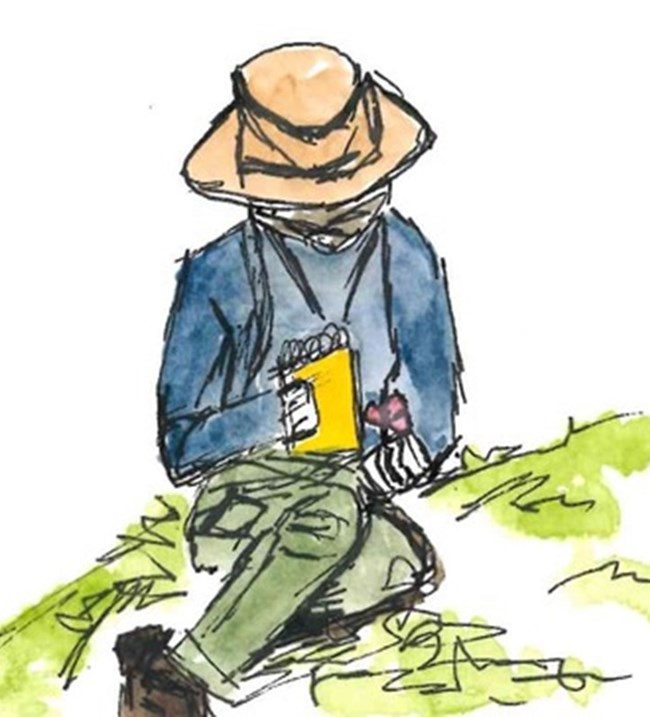
NPS Illustration / M. Perez
Real-time Documentation of Outbreak Spread
Park-based scientists living in and around Denali National Park and Preserve were poised to capture the effects of spruce beetle in real-time. After watching the beetle spread from the south for many years, by 2023 personnel were in place to document forest change. Through a network of nearly 50 plots, continued monitoring will track the rate and extent of spruce beetle spread and related spruce mortality over the next several years. Preliminary results show that the percentage of spruce in the study area that had been attacked by spruce beetle increased from about 5% to 10% between 2023 and 2024. The percentage of plots with a spruce beetle infested trees jumped from nearly 50% to nearly 75% across the same time period. In general, the bigger the tree, the greater chance it had been attacked.
The protocol used to track these changes is one that has been used to monitor vegetation in central Alaska for over 20 years. The protocol is effective at capturing change in vegetation across multiple structures (i.e, trees, saplings, shrubs, grass, etc.). Small modifications to the protocol for tracking outbreak spread also allowed for documentation of squirrel, bird, and small mammal populations.
Research conducted by Denali National Park and Preserve Botany Team
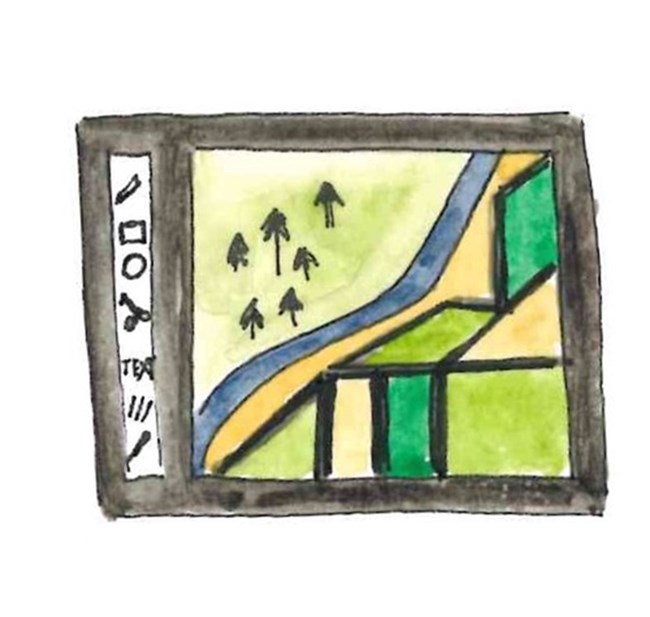
NPS Illustration / M. Perez
Outbreak Effects as Detected through Remote Sensing
Analysis of satellite imagery time-series in tandem with aerial survey reference data allows for estimation of beetle impacts across large areas. Within the last decade, Denali National Park and Preserve and surrounding has experienced between 45-60% spruce mortality in forested areas. On the landscape that is a loss equivalent to ~70 square miles (45,000 acres = 18,000 hectares = the size of the District of Columbia).
Research conducted by ABR, Inc. Environmental Research & Services in collaboration with the Denali National Park and Preserve Botany Team
Denali National Park and Preserve uses aviation (drone or fixed-wing aircraft) to capture photos of large-scale disturbance. These photos are processed with GPS coordinates by the Denali GIS specialist to create a mosaiced image that can be georeferenced in GIS. This product is then shared to individuals using remote sensing to study natural disturbances occurring in the park (ex. to track the timing and extent of beetle kill). Maps and georeferenced photos at the landscape scale are important in applying plot-based studies across the larger landscape.
Monitoring conducted by Denali National Park and Preserve GIS Specialist
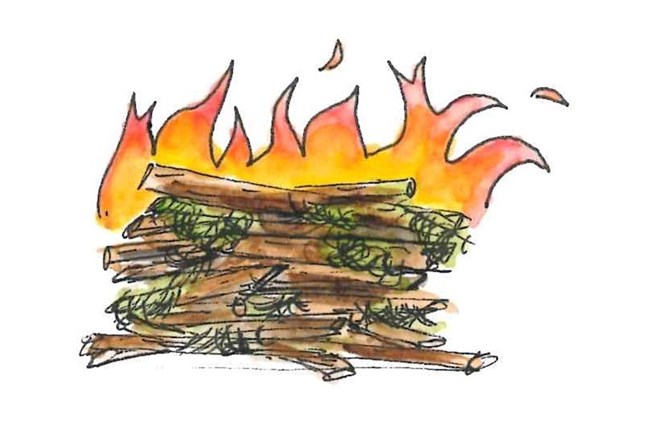
NPS Illustration / M. Perez
Fuel Treatment and Spruce Beetle Interactions
NPS Alaska’s Western Fire Management team, based in Denali, implements hand-thinning (fuel) treatments in areas surrounding Park infrastructure to minimize wildfire risk. Methods of hand-thinning include removing live trees, removing branches up to 6 feet from the ground, and placing all material into burn piles. When planning for fuel treatments, management must consider the impacts to ecological and cultural resources—this includes how spruce beetle populations and distribution will be affected by hand-thinning projects.
A Northern Arizona University graduate student conducted insect surveys in and around fuels treatments in 2023. They found no relationship between hand-thinning treatments and the presence of spruce beetle. However, they did find correlations between the amount of suitable woody debris piled at the site and the presence of live beetles. This suggests that slash piles can be used as ‘bait’ to attract beetles but should be burned before beetles are ready to disperse into surrounding healthy trees.
Research conducted by a Northern Arizona University Graduate Student
To examine this phenomenon over the longer-term, the local Fire Management Ecology Team has selected a subset of trees in and around fuel treatment sites to monitor over the next several years, as spruce beetle activity likely increases. The goal is to establish understanding of how thinning vegetation or piling slash affects likelihood of infestation over a 3-5 year period.
Monitoring conducted by NPS Alaska Fire Ecology Team

NPS Illustration / M. Perez
Canopy Mortality Effects on a Rare Lichen
The Boreal Felt Lichen (Erioderma pedicellatum) is a rare epiphytic lichen found on spruce tree branches in the moist forests growing along the southern boundary of Denali National Park and Preserve. It was documented by Park scientists in 2007. A habitat study conducted in 2013 estimated Denali’s population of the Boreal Felt Lichen to be over 10x the world’s then documented population! However, by 2018, these habitats had been heavily impacted by spruce beetle. Because the original study sites were set up to allow for long-term monitoring, the spruce beetle disturbance opened an opportunity to directly measure the change in the Boreal Felt Lichen population caused by spruce mortality. In this collaborative effort between Denali National Park and Preserve and a graduate student from the University of Northern Colorado, park scientists and researchers will be able to track how changes to the forest after severe beetle infestation affect habitat for the Boreal Felt Lichen and the unique epiphytic lichen communities they inhabit.
Research conducted by a University of Northern Colorado Graduate Student in collaboration with the Denali National Park and Preserve Fire Ecology and Botany Teams
Additionally, studying changes to forest structure post-infestation can provide insight into what to expect from forests currently infested. Because long-term monitoring (and thus pre-disturbance) data exists for these sites, researchers have the opportunity to directly measure changes in forest structure. Of particular interest is how vegetation (as potential fuel for wildland fire) has changed. For example, how much woody material is on the ground 5-years post-disturbance as compared to pre-disturbance. Information can be fed into fire behavior models to predict potential fire spread.
Monitoring conducted by NPS Alaska Fire Ecology Team
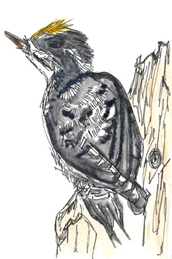
NPS Illustration / M. Perez
Birds and Beetles
A collaborative effort is underway to describe the immediate (short-term) and long-term responses of birds to the spruce bark beetle outbreak in the Denali area. Collating data collected by the long-term passerine monitoring program of the NPS I&M Central Alaska Network Monitoring Program, the North American Breeding Bird Survey, additional surveys supported by the Kessel Fellowship Award of the American Ornithological Society, and community science reports from eBird has proved fruitful in the tracking bird response to beetle outbreak.
Researchers have documented the rapid response of American Three-toed Woodpeckers to the tremendous resource pulse created by the super abundance of food – adult spruce beetles and their larva. Woodpeckers are an important natural predator of spruce beetles and rapidly colonize areas in the early stages of infestation.
The long-term passerine monitoring program was developed to provide data to detect changes in abundance and distribution of birds over time and in response to large-scale landscape changes such as the spruce beetle outbreak.
Monitoring conducted by the Denali National Park and Preserve Wildlife Biology Team and Collaborators
How Spruce Beetle Affects Insect Diversity
As spruce beetle populations rise, and habitats change due to spruce mortality, one may expect changes in the populations of other insects due to competition for changing habitat resources. Researchers from the University of Fairbanks and United States Geological Survey are collaborating to study how spruce beetle damage may impact the abundance and diversity of other insect groups in Denali National Park and surrounding areas. They will compare insect populations in areas with high spruce beetle mortality to those without, visiting traps bi-weekly throughout the summer months to tally numbers of pollinators and wood-living beetles. These insect groups serve important ecosystem functions and may be early indicators in change of habitat availability.
Research conducted by University of Alaska Fairbanks
Working Together to Document Forest Change
Long-term monitoring and short-term research go hand-in-hand to provide a more comprehensive understanding of changes in local ecosystems. Research is often intensely focused on answering one to several questions that may be immediately relevant. Monitoring is often more general and focused on being able to answer broad questions and track long-term trends. Baseline data and information as captured in long-term monitoring is critical in supporting shorter-term research by providing context. National Parks can be an excellent place to conduct research for this and many other reasons.
